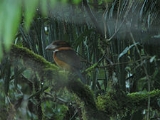
Shovel-billed Kookaburra
Encyclopedia
The Shovel-billed Kookaburra (Clytoceyx rex), also known as the Shovel-billed Kingfisher, is a large, approximately 33 cm (13 in) long, dark brown tree kingfisher
with a heavy, short and broad bill that is unique among the kingfisher
s. It has a dark head with rufous stripe behind eye, a white throat, rufous neck collar and underparts, bright blue rump, brown iris
, brownish-black bill
with paler mandible (entire bill often appears brownish due to earth) and pale feet. Both sexes are similar in appearance, but are easily recognized from the color of the tail. The male has a dark bluish tail while female's is rufous. The juvenile
has a female-like plumage
with scale-patterned feathers.
The sole representative of the genus
Clytoceyx, the Shovel-billed Kookaburra is endemic
to New Guinea
. It primarily occurs in hill forests, but has been recorded from sea-level up to an altitude of 2400 m (7850 ft). It finds its food in mud or on moist ground. The diet consists mainly of earthworms, snails, beetles, lizards and insects. It is inconspicuous and infrequently seen. It is likely that it is partially crepuscular
.
Widespread but uncommon throughout a large part of New Guinea, the Shovel-billed Kookaburra is evaluated as Least Concern
on the IUCN Red List
of Threatened Species.
Tree kingfisher
The tree kingfishers or wood kingfishers, family Halcyonidae, are the most numerous of the three families of birds in the kingfisher group, with between 56 and 61 species in around 12 genera, including several species of kookaburras. The family appears to have arisen in Indochina and the Maritime...
with a heavy, short and broad bill that is unique among the kingfisher
Kingfisher
Kingfishers are a group of small to medium sized brightly coloured birds in the order Coraciiformes. They have a cosmopolitan distribution, with most species being found in the Old World and Australia...
s. It has a dark head with rufous stripe behind eye, a white throat, rufous neck collar and underparts, bright blue rump, brown iris
Iris (anatomy)
The iris is a thin, circular structure in the eye, responsible for controlling the diameter and size of the pupils and thus the amount of light reaching the retina. "Eye color" is the color of the iris, which can be green, blue, or brown. In some cases it can be hazel , grey, violet, or even pink...
, brownish-black bill
Beak
The beak, bill or rostrum is an external anatomical structure of birds which is used for eating and for grooming, manipulating objects, killing prey, fighting, probing for food, courtship and feeding young...
with paler mandible (entire bill often appears brownish due to earth) and pale feet. Both sexes are similar in appearance, but are easily recognized from the color of the tail. The male has a dark bluish tail while female's is rufous. The juvenile
Juvenile (organism)
A juvenile is an individual organism that has not yet reached its adult form, sexual maturity or size. Juveniles sometimes look very different from the adult form, particularly in terms of their colour...
has a female-like plumage
Plumage
Plumage refers both to the layer of feathers that cover a bird and the pattern, colour, and arrangement of those feathers. The pattern and colours of plumage vary between species and subspecies and can also vary between different age classes, sexes, and season. Within species there can also be a...
with scale-patterned feathers.
The sole representative of the genus
Genus
In biology, a genus is a low-level taxonomic rank used in the biological classification of living and fossil organisms, which is an example of definition by genus and differentia...
Clytoceyx, the Shovel-billed Kookaburra is endemic
Endemism in birds
An endemic bird area is a region of the world that contains two or more restricted-range species, while a "secondary area" contains one or more restricted-range species. Both terms were devised by Birdlife International....
to New Guinea
New Guinea
New Guinea is the world's second largest island, after Greenland, covering a land area of 786,000 km2. Located in the southwest Pacific Ocean, it lies geographically to the east of the Malay Archipelago, with which it is sometimes included as part of a greater Indo-Australian Archipelago...
. It primarily occurs in hill forests, but has been recorded from sea-level up to an altitude of 2400 m (7850 ft). It finds its food in mud or on moist ground. The diet consists mainly of earthworms, snails, beetles, lizards and insects. It is inconspicuous and infrequently seen. It is likely that it is partially crepuscular
Crepuscular
Crepuscular animals are those that are active primarily during twilight, that is during dawn and dusk. The word is derived from the Latin word crepusculum, meaning "twilight." Crepuscular is, thus, in contrast with diurnal and nocturnal behavior. Crepuscular animals may also be active on a bright...
.
Widespread but uncommon throughout a large part of New Guinea, the Shovel-billed Kookaburra is evaluated as Least Concern
Least Concern
Least Concern is an IUCN category assigned to extant taxon or lower taxa which have been evaluated but do not qualify for any other category. As such they do not qualify as threatened, Near Threatened, or Conservation Dependent...
on the IUCN Red List
IUCN Red List
The IUCN Red List of Threatened Species , founded in 1963, is the world's most comprehensive inventory of the global conservation status of biological species. The International Union for Conservation of Nature is the world's main authority on the conservation status of species...
of Threatened Species.
External links
- BirdLife Species Factsheet
- IUCN Red List
- Photos and brief description of first known nest. Accessed 2008-07-10.

